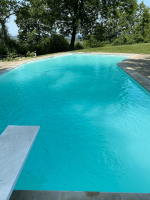While resurfacing the pool, following sandblasting a number of brass fittings became visible.
The deep end drain grate, a hydrostatic relief valve, and an attachment for buoys the separate the deep end are all made of brass.
The hydrostatic relief valve lost its spring (user mistake during draining or it has been without a spring for years, I'm unable to discern). The pool has had no leaking in the 3 years I've own it. (35,000 gallons, chlorine)
The pool resurfacing company wants to replace the old relief valve system with a whole PVC setup, including cutting into the cement/shell, replacing the old setup, and installing a PVC L-tube and PVC valve.
A web search found several brass hydrostatic relief valves that can be similar to what exists.
Seeking advice to: a) replace the entire setup, cutting and installing a new L-shape and PVC valve
or b) replacing the current valve with another brass valve, or just repairing the spring.
Likely option to follow even though is more intrusive:
The pool company prefers to replace it with a new PVC hydrostatic setup, cut the cement, install a L-shape and PVC valve that can be closed off while filled and open after draining.
I suppose this will have a better warranty in case if future leaks vs just replacing the the missing spring, or a new brass valve.
Advice to take the intrusive approach, which will be replasterred and made look even, and avoid future leaks,
or dont cut into the shell and just repair the existing valve.
(unfortunately while I did not have any leaks in the 3 years with the pool, I dont know if the spring or the valve was damaged while draining and I will have leaks afterwards....)
see images from amazon on potential brass hydrostatic valves

The deep end drain grate, a hydrostatic relief valve, and an attachment for buoys the separate the deep end are all made of brass.
The hydrostatic relief valve lost its spring (user mistake during draining or it has been without a spring for years, I'm unable to discern). The pool has had no leaking in the 3 years I've own it. (35,000 gallons, chlorine)
The pool resurfacing company wants to replace the old relief valve system with a whole PVC setup, including cutting into the cement/shell, replacing the old setup, and installing a PVC L-tube and PVC valve.
A web search found several brass hydrostatic relief valves that can be similar to what exists.
Seeking advice to: a) replace the entire setup, cutting and installing a new L-shape and PVC valve
or b) replacing the current valve with another brass valve, or just repairing the spring.
Likely option to follow even though is more intrusive:
The pool company prefers to replace it with a new PVC hydrostatic setup, cut the cement, install a L-shape and PVC valve that can be closed off while filled and open after draining.
I suppose this will have a better warranty in case if future leaks vs just replacing the the missing spring, or a new brass valve.
Advice to take the intrusive approach, which will be replasterred and made look even, and avoid future leaks,
or dont cut into the shell and just repair the existing valve.
(unfortunately while I did not have any leaks in the 3 years with the pool, I dont know if the spring or the valve was damaged while draining and I will have leaks afterwards....)
see images from amazon on potential brass hydrostatic valves







